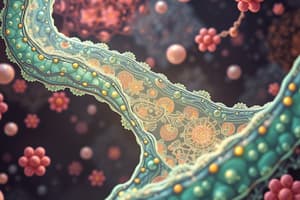Podcast
Questions and Answers
What is active transport and the forms of passive transport?
What is active transport and the forms of passive transport?
Active transport is the movement of molecules across a cell membrane from a region of lower concentration to a region of higher concentration, requiring energy. Passive transport includes diffusion, osmosis, and facilitated diffusion.
What is passive transport and the forms of active transport?
What is passive transport and the forms of active transport?
Passive transport is the movement of molecules across a cell membrane from a region of higher concentration to a region of lower concentration, without requiring energy. Active transport includes primary active transport, secondary active transport, and vesicular transport.
What are the 4 functions of cell division?
What are the 4 functions of cell division?
The 4 functions of cell division are repair of injured body parts, replacement of aging cells and cells that die from disease, assisting in the organism's growth, and reproduction through asexual reproduction.
Which structures in the cell help it to reproduce?
Which structures in the cell help it to reproduce?
What happens during the Interphase stage of the cell cycle?
What happens during the Interphase stage of the cell cycle?
Describe the process of DNA condensation during the Mitosis - Prophase stage.
Describe the process of DNA condensation during the Mitosis - Prophase stage.
What occurs during the Mitosis - Metaphase stage?
What occurs during the Mitosis - Metaphase stage?
Explain the process of chromatid separation during the Mitosis - Anaphase stage.
Explain the process of chromatid separation during the Mitosis - Anaphase stage.
What happens during the Mitosis - Telophase stage?
What happens during the Mitosis - Telophase stage?
Why is cell division essential for the growth of an organism?
Why is cell division essential for the growth of an organism?




